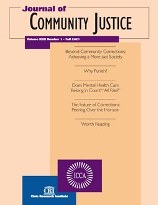Complete Issue
Author: Donald G. Evans.
Source: Volume 26, Number 03, Spring 2017 , pp.1-28(28)

< previous article |return to table of contents
Abstract:
This issue provides three informative articles of particular interest to community correctional practitioners. The first article argues for specialized courts for youth ages 18 to 24 that take into account evidence from the neurosciences on brain development and maturity. The second article explores the benefits derived from a partnership between a minimum security prison and a community advisory board. The final article deals with issues of addiction and recovery. These articles challenge us to think “outside the box” about what is possible in working with offenders toward their re-integration. In “Preventing the Transition From Juvenile Delinquency to Adult Crime” Dr. David P. Farrington raises the issue of individuals moving from the juvenile system to the adult system without taking their maturity into account. The individuals in question are in the 18- to 24-year-old age group, a group for whom recent advances in the research suggest a need for special treatment, employing a “maturity discount” and specialized courts. An example of this approach is the legislation recently introduced in the Netherlands to legally recognize a period of young adulthood (18 to 23), during which offenders would be sentenced using the juvenile criminal law. It is certainly a provocative suggestion, and based on the evidence, it deserves serious consideration. In “Effective Minimum Security Corrections: A Case Study Blueprint for Re-Integrative Success,” a very interesting case study on the impact on re-integrative success of a partnership between a community advisory board and a minimum security prison, Dr. R.L. McNeely and colleagues demonstrate the value of lay community oversight and participatory decision making. This article highlights the practices of a state department of corrections minimum security prison that had a community advisory board. It demonstrates how this partnership allowed the institution to move beyond warehousing offenders to providing re-integrative services. In “Intimacy of Addiction: Depths of Betrayal,”Dr. Randy Shively, director of research and clinical development at Alvis in Columbus, Ohio, and Leo Petrilli, is a peace officer in Canada who lectures on addictions to law enforcement officers and emergency service workers in Canada, use the analogy of relationships to explain the issues and treatment options for addicted individuals. They stress the need for service providers to never give up on those struggling with addiction and for committed social supports for these individuals.Keywords: Young adult offenders; developmental criminology; brain development; life transitions; prison oversight; inmate re-integration; correctional rehabilitation; addiction; brain disease; dopamine buildup; withdrawal
Affiliations:
1: Executive Editor.